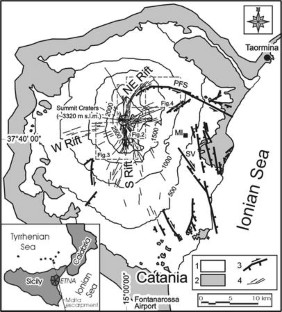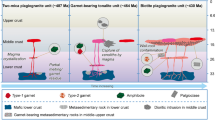Abstract
The 2002–03 Mt Etna flank eruption began on 26 October 2002 and finished on 28 January 2003, after three months of continuous explosive activity and discontinuous lava flow output. The eruption involved the opening of eruptive fissures on the NE and S flanks of the volcano, with lava flow output and fire fountaining until 5 November. After this date, the eruption continued exclusively on the S flank, with continuous explosive activity and lava flows active between 13 November and 28 January 2003. Multi-disciplinary data collected during the eruption (petrology, analyses of ash components, gas geochemistry, field surveys, thermal mapping and structural surveys) allowed us to analyse the dynamics of the eruption. The eruption was triggered either by (i) accumulation and eventual ascent of magma from depth or (ii) depressurisation of the edifice due to spreading of the eastern flank of the volcano. The extraordinary explosivity makes the 2002–03 eruption a unique event in the last 300 years, comparable only with La Montagnola 1763 and the 2001 Lower Vents eruptions. A notable feature of the eruption was also the simultaneous effusion of lavas with different composition and emplacement features. Magma erupted from the NE fissure represented the partially degassed magma fraction normally residing within the central conduits and the shallow plumbing system. The magma that erupted from the S fissure was the relatively undegassed, volatile-rich, buoyant fraction which drained the deep feeding system, bypassing the central conduits. This is typical of most Etnean eccentric eruptions. We believe that there is a high probability that Mount Etna has entered a new eruptive phase, with magma being supplied to a deep reservoir independent from the central conduit, that could periodically produce sufficient overpressure to propagate a dyke to the surface and generate further flank eruptions.












Similar content being viewed by others
References
Acocella V, Neri M (2003) What controls flank eruptions: the 2001 Etna eruption and the possible triggering mechanisms. Bull Volcanol 65:517–529 (DOI: 10.1007/s00445–003–0280–3)
Acocella V, Behncke B, Neri M, D’Amico S (2003) Link between major flank slip and eruptions at Mt. Etna (Italy). J Geophys Res 30(24):2286 (DOI:10.1029/2003GL018642)
Alparone S, Andronico D, Lodato L, Sgroi T (2003) Relationship between tremor and volcanic activity during the Southeast Crater eruption on Mount Etna in early 2000. J Geophys Res 108(B5):2241 (DOI: 10.1029/2002JB001866)
Andronico D, Coltelli M, Cristalli A, Del Carlo P, Scollo S (2003a) The 2002–2003 Etna ash fallout and its effects. Proc Cities on Volcanoes 3 Conf, Hilo Hawai’i, USA, 14–18 July 2003
Andronico D, Cristaldi A, Del Carlo P, Taddeucci J (2003b) Monitoring the ashes from the 2002–2003 flank eruption of Mount Etna (Italy). EAE03-A-06783, EAE03-A-06783, EGS-AGU-EUG Joint Assembly, Nice, France, April 2003
Armienti P, Innocenti F, Petrini R, Pompilio M, Villari L (1988) Sub-aphyric alkali basalt from Mt. Etna: inferences on the depth and composition of the source magma. Rend Soc It Mineral Petrol 43:877–891
Azzaro R, Branca S, Giammanco S, Gurrieri S, Rasà R, Valenza M (1998) New evidence for the form and extend of the Pernicana Fault System (Mt. Etna) from structural and soil-gas surveying. J Volcanol Geoth Res 84:143–152
Behncke B, Neri M (2003a) The July-August 2001 eruption of Mt. Etna (Sicily). Bull Volcanol 65:461–476 (DOI: 10.1007/s00445–003–0274–1)
Behncke B, Neri M (2003b) Cycles and trends in the recent eruptive behaviour of Mount Etna (Italy). Can J Earth Sci 40:1405–1411 (DOI: 10.1139/E03–052)
Billi A, Acocella V, Funiciello R, Giordano G, Lanzafame G, Neri M (2003) Mechanisms for ground-surface fracturing and incipient slope failure associated to the July-August 2001 eruption of Mt. Etna, Italy: analysis of ephemeral field data. J Volcanol Geoth Res 122:281–294
Blaserna P, Silvestri O, Gemmellaro C (1879) L’eruzione dell’Etna del 26 Maggio 1879. Relazione della Commissione nominata dai Ministri di Agricoltura Industria e Commercio e della Pubblica Istruzione, Tipografia Eredi Botta, Roma, Italia, pp 1–13
Branca S, Del Carlo P (2004) Eruptions of Mt Etna during the past 3,200 years: a revised compilation integrating the historical and stratigraphic records. In: Bonaccorso A, Calvari S, Coltelli M, Del Negro C, Falsaperla S (eds) Etna volcano laboratory. AGU (Geophysical monograph series), Washington, DC 143:384
Branca S, Carbone D, Greco F (2003) Intrusive mechanism of the 2002 NE-Rift eruption at Mt. Etna (Italy) inferred through continuous microgravity data and volcanological evidences. Geophys Res Lett 30(20):2077 (DOI:10.1029/2003GL018250)
Bruno N, Caltabiano T, Romano R (1999) SO2 emissions at Mt. Etna with particular reference to the period 1993–1995. Bull Volcanol 60:405–411
Bruno N, Caltabiano T, Giammanco S, Romano R (2001) Degassing of SO2 and CO2 at Mount Etna (Sicily) as indicator of pre-eruptive ascent and shallow emplacement of magma. J Volcanol Geoth Res 110:137–153
Burton M, Allard P, Murè F, Oppenheimer C (2003) FTIR remote sensing of fractional magma degassing at Mt. Etna, Sicily. In: Oppenheimer C, Pyle DM, Barclay J (eds) Volcanic degassing. Geological Society (Special Publications), London, 213:281–293
Caltabiano T, Romano R (1988) Messa a punto di metodologie di misura con apparecchiatura COSPEC del flusso di SO2 da vulcani attivi italiani. Boll GNV IV:133–145
Caltabiano T, Romano R, Budetta G (1994) SO2 measurements at Mount Etna, Sicily. J Geophys Res 99:12809–12811
Calvari S, Pinkerton H (2002) Instabilities in the summit region of Mount Etna during the 1999 eruption. Bull Volcanol 63:526–535
Calvari S, Pinkerton H (2004) Birth, growth and morphologic evolution of the “Laghetto” cinder cone during the 2001 Etna eruption. J Volcanol Geoth Res (in press)
Calvari S, Coltelli M, Neri M, Pompilio M, Scribano V (1994) The 1991–1993 Etna eruption: chronology and lava flow-field evolution. Acta Vulcanol 4:1–14
Calvari S, and the whole scientific staff of INGV – Sezione di Catania (2001) Multidisciplinary approach yields insight into Mt. Etna 2001 eruption. EOS Transactions, AGU 82:653–656
Calvari S, Neri M, Pinkerton H (2002) Effusion rate estimations during the 1999 summit eruption on Mt. Etna, and growth of two distinct lava flow fields. J Volcanol Geoth Res 119:107–123
Calvari S, Lodato L, Burton M, Andronico D (2003) Dike emplacement at Mount Etna before the 2002 flank eruption revealed by surveys with a portable thermal camera. EGS-AGU-EUG Joint Assembly, Nice, France, April 2003, Geophys Res Abstr 5:05329
Coltelli M, Pompilio M, Del Carlo P, Calvari S, Pannucci S, Scribano V (1998) Mt. Etna 1993–95 Eruptive activity. Acta Vulcanol 10:141–148
Coltelli M, Del Carlo P, Pompilio M (2000a) Etna: Eruptive activity in 1996. Acta Vulcanol 12(1):63–67
Coltelli M, Del Carlo P, Vezzoli L (2000b) Stratigraphic constraints for explosive activity in the past 100 ka at Etna Volcano, Italy. Int J Earth Sci 89:665–677
Corsaro RA, Pompilio M (2004a) Magmatic processes in the shallow plumbing system of Mt. Etna as recorded by compositional variations in volcanics of recent summit activity (1995–1999). J Volcanol Geoth Res (in press)
Corsaro RA, Pompilio M (2004b) Magma dynamics at Mount Etna. In: Bonaccorso A, Calvari S, Coltelli M, Del Negro C, Falsaperla S (eds) Etna volcano laboratory. AGU (Geophysical monograph series), Washington, DC 143:384
Cucuzza Silvestri S (1949) L’eruzione dell’Etna del 1947. Bull Volcanol II, IX:81–111
Cumin G (1947) Dati e considerazioni sulla recente eruzione. “Vie economiche” del 15 Marzo 1947, Catania
Cumin G (1950) L’eruzione laterale etnea del dicembre 1949. Boll Acc Gioenia Sci Nat Catania IV:1–7
Del Carlo P, Branca S (1998) Tephrostratigraphic dating of the pre-1300 AD SE flank eruptions of Mt Etna. Acta Vulcanol 10:33–37
Francis P, Burton MR, Oppenheimer C (1998) Remote measurements of volcanic gas compositions by solar occultation spectroscopy. Nature 396:567–570
Garduño VH, Neri M, Pasquarè G, Borgia A, Tibaldi A (1997) Geology of the NE-Rift of Mount Etna (Sicily, Italy). Acta Vulcanol 9:91–100
Groppelli G, Tibaldi A (1999) Control of rock reology on deformation style and slip-rate along the active Pernicana Fault, Mt. Etna, Italy. Tectonophysics 305:521–537
Harris AJL, Neri M (2002) Volumetric observations during paroxysmal eruptions at Mount Etna: pressurized drainage of a shallow chamber or pulsed supply? J Volcanol Geoth Res 116:79–95
Kieffer G (1975) Sur l’existence d’une “Rift zone” à L’Etna. CR Acad Sci Paris D 280:236–266
Lanzafame G, Neri M, Acocella V, Billi A, Funiciello R, Giordano G (2003) Structural features of the July-August 2001 Mount Etna eruption: evidence for a complex magma supply system. J Geol Soc London 160:531–544
Le Maitre RW (1989) A classification of igneous rocks and glossary of terms. Recommendations of the IUGS Subcommission on the Systematics of Igneous rocks. Blackwell Scientific, London, pp 193
McGuire WJ, Pullen AD (1989) Location and orientation of eruptive fissures and feeder-dykes at Mount Etna: influence of gravitational and regional tectonic stress regimes. J Volcanol Geoth Res 38:352–344
Neri M, Acocella V, Behncke B (2004) The role of the Pernicana Fault System in the spreading of Mount Etna (Italy) during the 2002–2003 eruption. Bull Volcanol (in press, DOI: 10.1007/s00445–003–0322)
Patanè D (2002) Aggiornamento delle attività di monitoraggio sismico all’Etna. http://www.ct.ingv.it/report/Rapporto_eruzione20021030.pdf
Patanè D, De Gori P, Chiarabba C, Bonaccorso A (2003) Magma ascent and the pressurization of Mount Etna’s volcanic system. Science 299:2061–2063
Pyle DM (1989) The thickness, volume and grain size of tephra fall deposits. Bull Volcanol 51:1–15
Pompilio M, Coltelli M, Del Carlo P, Vezzoli L (1995) How do basaltic magmas, feeding explosive eruptions, rise and differentiate at Mt. Etna? Period Mineralogia 64:253-254
Pompilio M, Corsaro RA, Freda C, Miraglia L, Scarlato P, Taddeucci J (2001) Petrological evidence of a complex plumbing system feeding the July-August 2001 eruption of Mt. Etna. EOS, AGU Trans – Fall Meeting Suppl Abstr 82(47):F1412
Ponte G (1948) L’eruzione dell’Etna del Febbraio-Marzo 1947. Ann Geofis 1:56–68
Recupero G (1815) Storia naturale e generale dell’Etna. Edizioni Dafni, Tringali Editore, Catania, 1970
Rittmann A (1965) Notizie sull’Etna. Nuovo Ciment I 3:1117–1123
Romano R, Sturiale C (1982) The historical eruptions of Mt. Etna (Volcanological data). Mem Soc Geol It 23:75–97
Salerno G, Caltabiano T, Bruno N, Longo V (2003) Anomalous SO2 emissions from Mt. Etna between 2001 and 2002–2003 eruptions. EGS-AGU-EUG Joint Assembly, Nice, France, April 2003, Geophysical Research Abstracts 5:11953
Silvestri O (1879) Sulla doppia eruzione scoppiata il 26 Maggio 1879. Rapporto alle LL.EE. i Ministri dell’Interno dell’Istruzione Pubblica, e di Agricoltura, Industria e Commercio. Tipografia Galatolà, Catania, pp 1–19
Taddeucci J, Pompilio M, Scarlato P (2002) Monitoring the explosive activity of the July-August 2001 eruption of Mt. Etna (Italy) by ash characterization. Geophys Res Lett 29:1029–1032
Tonarini S, Armienti P, D’Orazio M, Innocenti F, Pompilio M, Petrini R (1995) Geochemical and isotopic monitoring of Mt. Etna 1989–93. Eruptive activity: bearing on the shallow feeding system. J Volcanol Geoth Res 64:95–115
Acknowledgements
We wish to thank G. Bertolaso and the Civil Protection for their substantial support of our activities; the helicopter pilots of Civil Protection, Air Walser, and the Fire Service, whose expertise has allowed us to collect a huge amount of data; colleagues of INGV from Catania, Napoli, Roma and Pisa, and from the Universities of Milan, Bologna, Cosenza and Catania who helped during our monitoring efforts, and E. Boschi who strongly encouraged this work. The paper benefited from meticulous and thoughtful reviews by M. Edmonds and C. Heliker.
Author information
Authors and Affiliations
Corresponding author
Additional information
Editorial responsibility: J. Donnelly-Nolan
Rights and permissions
About this article
Cite this article
Andronico, D., Branca, S., Calvari, S. et al. A multi-disciplinary study of the 2002–03 Etna eruption: insights into a complex plumbing system. Bull Volcanol 67, 314–330 (2005). https://doi.org/10.1007/s00445-004-0372-8
Received:
Accepted:
Published:
Issue Date:
DOI: https://doi.org/10.1007/s00445-004-0372-8




